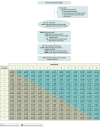Small-Volume Blood Collection Tubes to Reduce Transfusions in Intensive Care: The STRATUS Randomized Clinical Trial
- PMID: 37824152
- PMCID: PMC10570918
- DOI: 10.1001/jama.2023.20820
Small-Volume Blood Collection Tubes to Reduce Transfusions in Intensive Care: The STRATUS Randomized Clinical Trial
Abstract
Importance: Blood collection for laboratory testing in intensive care unit (ICU) patients is a modifiable contributor to anemia and red blood cell (RBC) transfusion. Most blood withdrawn is not required for analysis and is discarded.
Objective: To determine whether transitioning from standard-volume to small-volume vacuum tubes for blood collection in ICUs reduces RBC transfusion without compromising laboratory testing procedures.
Design, setting, and participants: Stepped-wedge cluster randomized trial in 25 adult medical-surgical ICUs in Canada (February 5, 2019 to January 21, 2021).
Interventions: ICUs were randomized to transition from standard-volume (n = 10 940) to small-volume tubes (n = 10 261) for laboratory testing.
Main outcomes and measures: The primary outcome was RBC transfusion (units per patient per ICU stay). Secondary outcomes were patients receiving at least 1 RBC transfusion, hemoglobin decrease during ICU stay (adjusted for RBC transfusion), specimens with insufficient volume for testing, length of stay in the ICU and hospital, and mortality in the ICU and hospital. The primary analysis included patients admitted for 48 hours or more, excluding those admitted during a 5.5-month COVID-19-related trial hiatus.
Results: In the primary analysis of 21 201 patients (mean age, 63.5 years; 39.9% female), which excluded 6210 patients admitted during the early COVID-19 pandemic, there was no significant difference in RBC units per patient per ICU stay (relative risk [RR], 0.91 [95% CI, 0.79 to 1.05]; P = .19; absolute reduction of 7.24 RBC units/100 patients per ICU stay [95% CI, -3.28 to 19.44]). In a prespecified secondary analysis (n = 27 411 patients), RBC units per patient per ICU stay decreased after transition from standard-volume to small-volume tubes (RR, 0.88 [95% CI, 0.77 to 1.00]; P = .04; absolute reduction of 9.84 RBC units/100 patients per ICU stay [95% CI, 0.24 to 20.76]). Median decrease in transfusion-adjusted hemoglobin was not statistically different in the primary population (mean difference, 0.10 g/dL [95% CI, -0.04 to 0.23]) and lower in the secondary population (mean difference, 0.17 g/dL [95% CI, 0.05 to 0.29]). Specimens with insufficient quantity for analysis were rare (≤0.03%) before and after transition.
Conclusions and relevance: Use of small-volume blood collection tubes in the ICU may decrease RBC transfusions without affecting laboratory analysis.
Trial registration: ClinicalTrials.gov Identifier: NCT03578419.
Conflict of interest statement
Figures


Comment in
References
-
- Hod EA, Francis RO. Noninfectious complications of blood transfusion. In: Cohn CS, Delaney M, Johnson ST, eds. AABB Technical Manual. 20th ed. HPC International; 2020:627.

